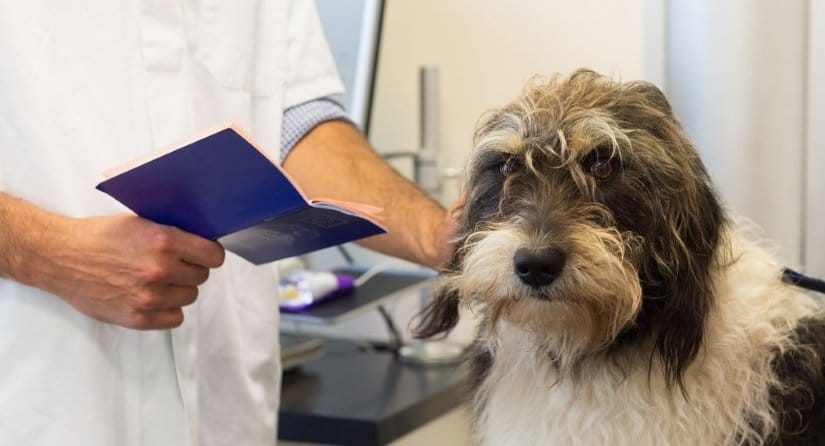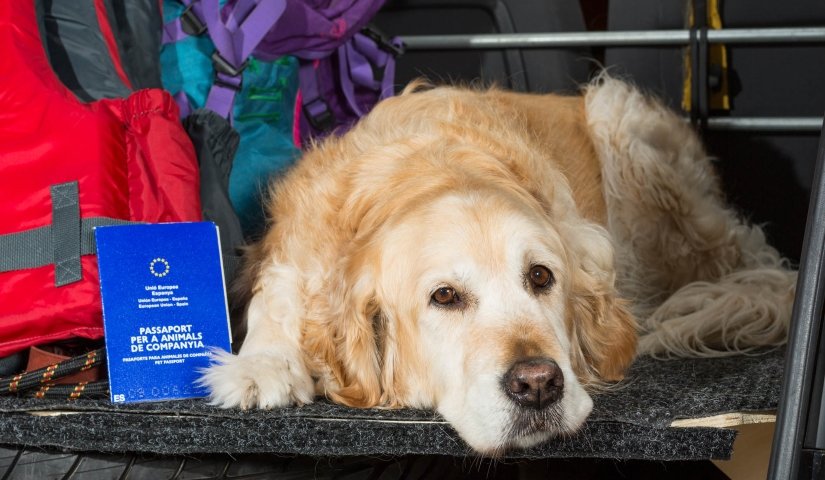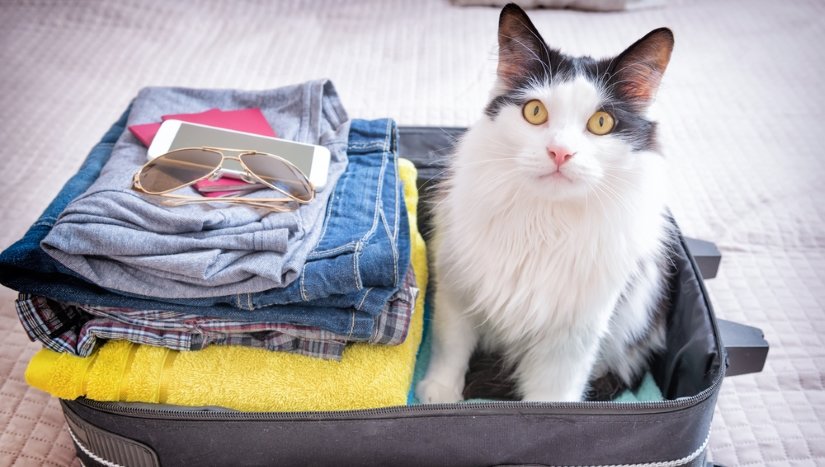
Traveling with your pet can be a lovely experience. When doing so from state to state, all you need are some training, some guidance if a first timer, and your pet essentials. However, when it comes to travel with dog to the shores of another country, there are more things to check, a pet passport is one of them.
We have put up a detailed article to provide you with all the information and steps you need to quickly book your next flight with your favorite pooch tagging along.
Pet Passport
The Term pet passport refers to the Pet Travel Scheme (PETS) which originated in Europe. It is a simple document that houses detailed information about your pet history and serves as proof that they have met the health requirement of the region. When you have the pet passport, to travel with pet becomes easy in the various regions that recognize the PETS.
Here is the information you will find in your pet passport:
- Ownership
- Microchip
- Tapeworm treatment
- Rabies vaccination
- Rabies blood test
- Description
While this is what a pet passport means, the definition now harbors another meaning. It now refers to all the document you must acquire to get entrance to another country with your pet tagging along. These documents will vary according to the region you intend to visit. However, one of the additional information required is the veterinary certificate issued before a week or two of travel.
Countries that recognize the pet scheme
The following are the countries that share the same pet requirements for their pet passport. Hence, as of the time of this article, if you meet the prerequisites and obtain your pet passport for one of this country, then you can travel with dog to any of these other countries:
- Croatia
- Denmark
- Austria
- Belgium
- Estonia
- Republic of Cyprus
- Czech Republic
- Lithuania
- Finland
- Greece
- France
- Hungary
- Germany
- Latvia
- Italy
- Ireland
- Malta
- Luxembourg
- Poland
- Netherlands
- Slovenia
- Romania
- Portugal
- Slovakia
- Sweden
- Spain
The UK is the founder of the PETS scheme. However, we have chosen not to include them on this list because it was done before their decision to separate from the European Union. Hence, after the separation, they might adjust their requirements. If you will be heading there, ensure to check their prerequisites to be sure you have met all of them.
Also, before leaving for any of these countries, it is always good to double check their requirements as they could change. If there happen to be a temporary health problem or outbreaks travel with pet can interpret sudden additional regulations. Hence, it is safer to make sure.
Getting your pet passport

Getting your canine’s pet passport incurs a long delivery process because of its personalized nature. However, where to purchase one is easy. Various websites exist that sell PETS. Before you go ahead to apply there are some prerequisites your fur-friend must meet:
- First, your lovely pooch has to be at least three to four months old.
- They have to be vaccinated for rabies: depending on the country you are traveling to the window from the day of vaccination to the day of the trip will vary. Some regions require that you vaccinate your lovely furryball three to four weeks before the day of travel for your pet passport to be considered valid.
- They have to be microchipped: ensure you know what area your canine is microchipped. It is important. Regarding a standard location, there is no one; it varies. Just ensure that it is anywhere from the shoulder blade to the side of his or her neck.
It is good to give yourself six months of digging before the d-day of travel. This will ensure that you have enough time to cover all the information needed and meet the desired requirements. Also, you can’t expect the pet passport purchase process to be quick enough to venture your trip in time. The best option is to apply within 5 to 8 weeks to ensure everything works out fine.
Depending on the country you want to travel with dog, you might be asked for additional documents and preparatory treatments. These materials might include further certifications from your vet. Also, don’t forget to check the airline you will be travaling with always. They might have or change their restrictions and rules that might affect your canine.
How much pet passports cost
To travel with pet will require a considerable amount of money. Presenting you with an estimate will be erroneous on our part. There are fees you will have to pay to get your pet passport, and they are likely to run into hundreds of dollars. Those fees might vary depending on your intended location and if you have already paid for some of them. However, to derive your estimate, the following are services you are likely to pay for:
- Filling out forms
- Parasite test
- Blood titer test
- Processing charges for permits
- Veterinarian fees
- Pet passport
Traveling restrictions for dogs

The limits for dogs might vary depending on the country you are heading to. Some of these rules take months to meet; another reason for you to plan early. However, there are some rules that are relative and will surely bar your four-legged from entering your desired country:
- They are up to four months old
- Ensuring your pet has been treated for tapeworm no earlier than 24 hours before making your trip.
- They are vaccinated for rabies within 21 days of travel
Even not properly treating your canine can lead to them being denied entry to your travel destination. Hence, it is essential that all your documentation and treatment are done by a licensed vet and are properly recorded.
Pet quarantine Requirements
Most countries require that your pet undergoes quarantine before landing on their soil. Now, the quarantine process can take up to 6 months. Having your pet passport and other travel documents ready can reduce the time but might not be enough if you are planning a short trip.
Depending on the country you are coming from (if it is rabies free or controlled or not) you can enjoy a lesser time. For countries that are rabies free or managed, the process is faster. However, those with worse rabies outbreaks and poor control suffer harsher regulations.

The following countries are either rabies free or properly managed as of the time of writing:
- Greece
- Ireland
- Canada
- Chile
- France
- Fiji
- Germany
- Guadeloupe
- American Samoa
- Barbados
- Bermuda
- Argentina
- Malta
- Australia
- Mexico
- Italy
- Japan
- Jamaica
- Spain
- Singapore
- Puerto Rico
- Spain
- Russia
- USA
- UAE
- UK
The quarantine rules in various countries vary. You might also be asked to provide a recent blood tilter test to verify your pet’s health and vaccination status. Doing this will speed up the quarantine process. Before deciding to travel with pet, check the quarantine regulations of the country you are visiting to see if you can meet their demands with the time window you have.
Requirements of a US pet passport
Whether you are a US citizen returning to your homeland or a citizen of another country intending to build a life in America, taking your pet along requires that you have a pet passport that meets the USA pet requirements.
The following is the information your pet passport must contain for him or her to gain admittance into the US:
- Microchip: The US won’t deny your canine entry if he or she doesn’t have a microchip implant. However, for the sake of identification, if lost, you are recommended to use a 15 digit 11784 complaint chip. Also, you should register your information before traveling so that your pup can easily be identified if lost.
- Vaccinated for rabies: if you are coming from countries with a high rabies outbreak, then your pet passport will include the treatment information. If your dog hasn’t been vaccinated before, you have to ensure he or she gets treated before 28 days to travel. However, if they have been vaccinated for rabies during their three months of age and you have the history to show, then you don’t need to wait after the last immunization before the travel.
- No Screworm certified: if you are coming from a screwworm infected country, then your canine has to been inspected and verified negative of screwworm five days before the day of travel. To find out the countries considered to be battling with screwworms check here.
- Import Permit: you have to purchase an import permit if you plan on moving your fur-friend to the United States.
- Tapeworm vaccination: shortly before leaving your country to the US, your canine should be treated for tapeworm if he or she will be helping out in the rearing of livestock.
- Your name and address: this is to be able to reach you in the circumstance that your dog goes missing.
- Veterinarian details: for the sake of confirming the information provided, your pet document must include contact and verifiable details regarding him or her.
- Detailed description: the pet passport will have to bear detailed information regarding your furry ball. This data will include his or her sex, date of birth, breed, and description.
It is vital that all these are done by a licensed vet and recorded adequately for a smooth process. The US does not require a blood tilter test from any country. However, for those coming from Egypt, you can’t bring your pet along to the States unless, before your travel, your pet resides in a rabies-free country, is vaccinated for rabies, and spends up to six months in the rabies-free region after the treatment.
Preparing for the trip

Now, you have rounded information regarding your pet passport. Let’s explore how you can prepare for your travel with pet.
- Check the requirements: before you start making arrangements for pet essentials, look into what is required for your canine to be accepted by the host country and the airline. To do this, you can check out the USDA website for your intended location. Check out the embassy website of your host country, and also call their embassy to be sure.
- Check the airline requirement: the airline that will take you to your destination should be checked too. Some airlines have stricter rules than host countries. For this reason, it is wise to investigate what goodies they have for you. If you are in the US, then here are the regulations for Delta, United, and America airlines; the three most used airlines in the US.
- Call your vet: now that you are aware of the requirements, it is time to inform your vet of what you need. It might take some visits to the vet before your loyal companion is fit to travel.
- Special certification: you want to make things easier? Get your issued vet certificate endorsed by the USDA. It might not be mandatory in some locations, but it helps speed up your travel process. If it is compulsory, then the more reason to make it happen. To have it endorsed, you can send it by mail, carrier, or in person after booking
- Get a dog sitter: there is a chance that your vet might find your pooch unfit for travel. In such a situation, despite how emotionally difficult, it is for you, you have to discourse the option of leaving him or her behind. Depending on how long the trip will be, you could leave your fur-friend in the hands of relatives, sell, or higher a dog seater.
-
Keep them safe: depending on the country you are coming from, there might be health risk that can deter your pet from traveling. To make things easier for you, it is wise to protect him or her from those dangers before they strike. If the area harbors screwworms or foot and mouth disease, you should:
- Regularly keep their fur, bed, and nails clean from straws, muds, dirt, and any other natural fibers.
- Keep them away from other livestock for at least five days after their arrival in your host country.
- Also, once you have arrived, bathe them.
- Coming home: when it is time to return, don’t quickly hop into the plane with your furry friend. Ensure that you have rechecked the requirements. The conditions might change on your return due to circumstances or the destination you traveled to.
If you plan on embarking on your trip in the closing months of the year, due to the tiresome process of getting your pet friend cleared, you should begin your research and preparations at the beginning of the year. This way, you will have enough time to make the proper arrangement regardless of if your pet will end up coming along or not.
What to do for unusual pets
Though the animals popularly regulated are dogs, cats, and ferret, you shouldn’t rule out your pet if he or she isn’t one of them. Those animals can still gain access to any host country if you meet their requirements. They might request for permits, medical records, and more.

If you are in the US, you can check the CDC (center for disease control and prevention) for information regarding what to do for the following pets:
- Dogs
- Cats
- Monkeys
- Civets
- Turtles
- Snakes
- African rodents
- Bats
This organization is also in charge of the regulation of zoos in the state. Other departments you can hunt for information regarding your pet are the United States Fish and Wildlife Service and the United States Department of Agriculture (USDA).
The process of gaining entrance into another country for your unusual pet won’t be easy. However, ready your mind for some sad news based on the kind of pet you have. For example, bats are not allowed to be imported into the US as pets. Also, Monkeys and African rodents might leave their native land only never to be allowed to return.
Another hiccup in your journey is the state laws. Some countries like the United States may have not only federal laws that cover the international requirements but have states laws that could endanger your pet if not observed. For this reason, it is good to research and weigh your options carefully; you don’t want to get stocked.
Summary
Taking your pet with you for relocation abroad or a long trip is fun and ideal. Who will want to leave their furry ball while on such a journey? The problem is, the laws of each country doesn’t share in that sentiment in the way we do. Safety and fairness are important. Hence, it is good to be objective and think about what is best for you and your pup before embarking the trip. Here we have elaborated on all you need to know to make your journey a wonderful one!